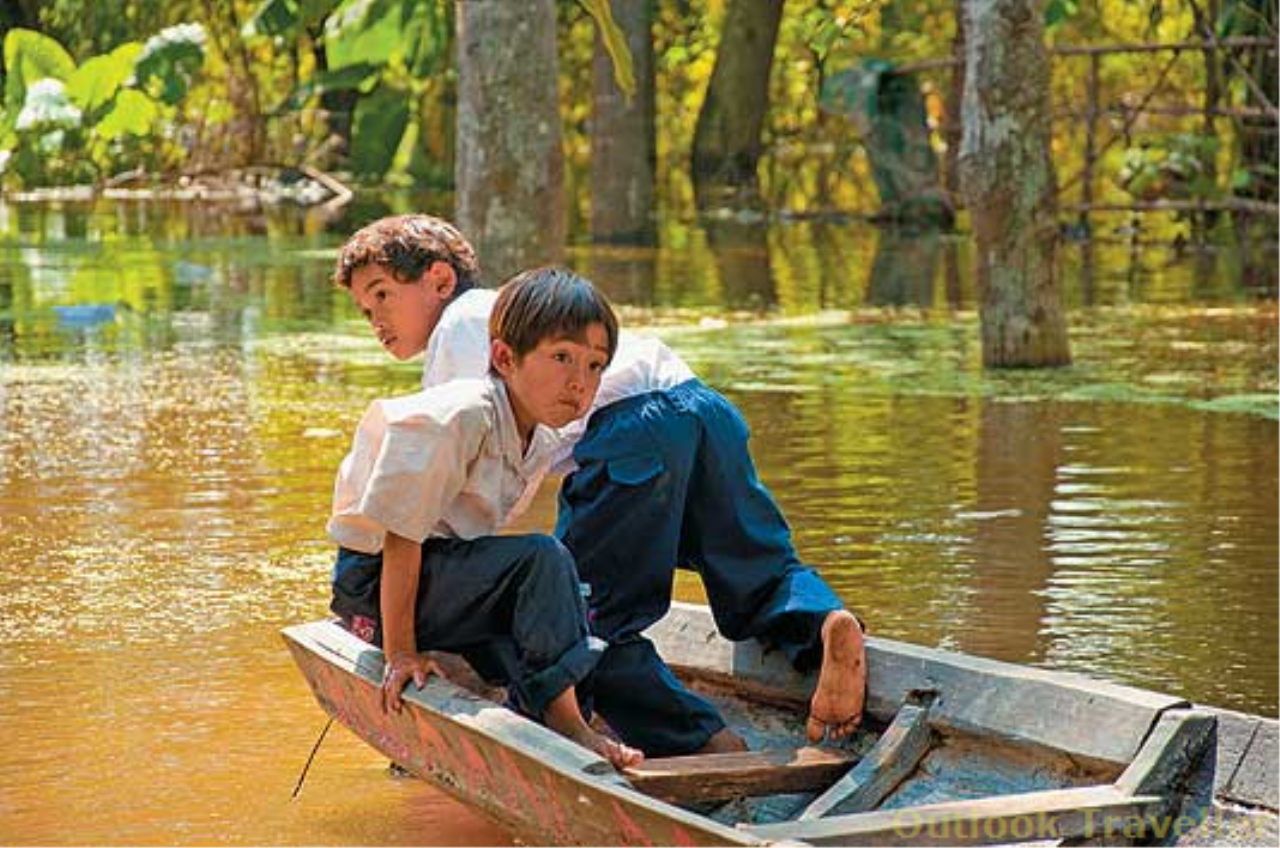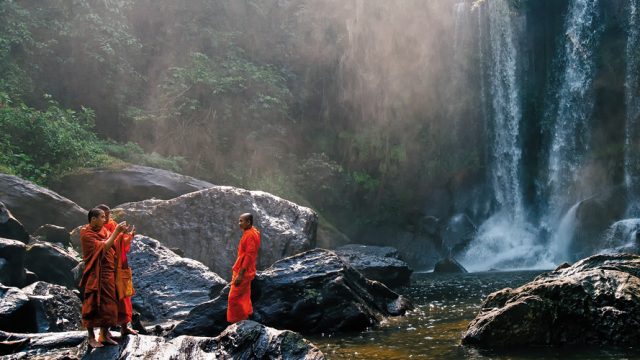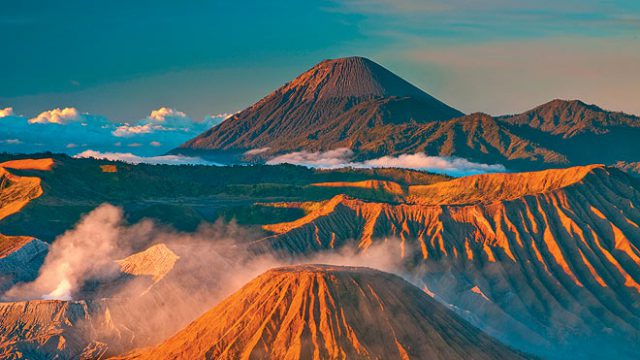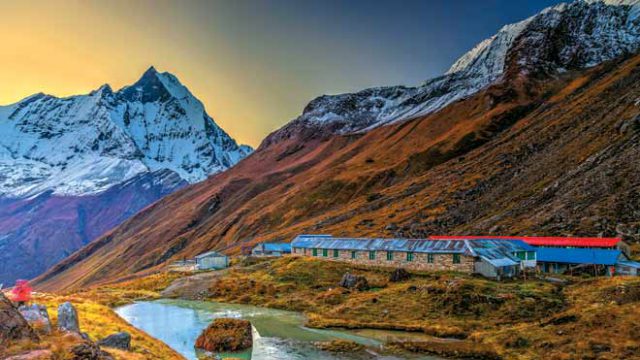No one goes to Vietnam without some
Saigon’s not about the sights, though there is some pleasing colonial architecture on view. You go to Saigon to cheer on the traffic, particularly its charming cyclos and the relentless flood of motorbikes (some ply as taxis—called xe ôm or ‘hug vehicle’ here). I could have gaped at these hell’s angels forever (there are three million, after all) but I had gone to Saigon not as a traffic voyeur but to catch a boat.
When the prospect of my charting the Mekong aboard a luxury cruiser first reared itself, it drew sour glances from my colleagues. That’s all the encouragement I needed. The Mekong is one of the grand rivers of Asia (vital stats: six countries, 4,900km, tenth-longest in the world), and the allure of a journey along it, pardon me, on it, was irresistible.
Before the boat, there is a bus ride, as the cruise toots off from My Tho, seventy kilometres south of Saigon. The storied National Route 1A, newly renovated, zips my fellow passengers and me past the electric green paddies of the Mekong delta—the defining image of ’Nam. A third annual crop of rice (they don’t call it fertile for nothing) is flourishing all around, the fields marked with modest family graves—the Vietnamese bury their dead in their own land. The guide prevents us from nodding off with all sorts of chinwag, from the finer points of watermelon cultivation to where to get one’s pho fix. Happyland, an entertainment complex Michael Jackson’s father is promoting among the paddies, swings to a side. We roll into port and an inviting MV Jayavarman snaps into view, our home for the next seven nights.
I haven’t been expecting anything in particular, but do register a moment’s surprise to find my cabin not unlike a well-equipped, if downsized, hotel room. There are floor-to-ceiling French windows, leading on to a private balcony—only this one has water lapping next to it. I fall for the bespoke detailing. Exquisite hand fans and grass hats for use during the cruise. A brass basin polished to a shine. A toy broom to hang outside when you want the room spruced up. A functioning dial phone—when did you last use one?—manufactured by Western Electric, whose last owner was the US Army (this nugget from an inspection of its underside). A scrollholder that spills a welcome note.
And then we’re off into the quiet evening. From My Tho, the Jayavarman will chug upstream to the floating market town of Cai Be, cross the Cambodian border at Chau Doc, dock at Phnom Penh and sail across the oceanic Tonle Sap lake, before dropping anchor a final time at the very steps of Angkor. All in all, we’ll clock an impressive 770km.
The next morning brings tai-chi lessons on the sundeck, coffee so good it calls for no sugar and the renewal of casual introductions made over last night’s lavish welcome buffet. Also our very first excursion, aboard a traditional sampan, to Cai Be.
Cai Be is nothing like the Thai floating markets you may know, where there are more floating tourists than vendors to be seen. This is the real deal, a messy congregation of boats—their bows painted with eyes in keeping with local custom—laden with all manner of produce from all over the delta. Cai Be’s imposing Gothic cathedral seems to float on the water. We alight at a charming French villa, built 1938. There are poignant family portraits, a sprawling fruit orchard, a snake rustling on the tarp above, a friendly dog. Next on, the Phu An hamlet, reassuringly touristy, peddling everything from rice paper (to wrap spring rolls) to python fat (great for cracked skin). There are demonstrations of candy making and rice being popped (even noodles, popped the same way). Snake wine is offered but, without exception, everyone stays with the banana wine.
Then it’s back to the ship, anchored mid-stream, where the lunch gong has gone off. I’m merely two meals down but I can say this with my hand on my tum: they could just as easily brand this a culinary cruise (incidentally, it’s christened ‘The Lost Civilization’). Meal after meal, Chef Sam Ang’s team serves up ambrosia on a platter. While dinners tend to be three- or five-course affairs, lunches are sumptuous buffets. Dry supplies and meats are stocked up before sailing, but vegetables, fruits and fish are picked up along the way, so one eats superbly as well as locally. The selection of salads at the first lunch: fried okra salad, kimchi, banana flower and chicken salad, pomelo and dried shrimp salad, Mediterranean pasta salad and then some. Not convinced? Here’s the salad spread from the next afternoon: Cambodian omelette salad, young lotus salad, prawn and avocado salad, lotus root salad, spicy pork salad, tuna fish salad… On this cruise, I could live on salads alone (but I don’t, of course). I take copious post-facto notes, intending to salivate over them on arid winter evenings, before realising the day’s menu is always on display outside the dining hall. I switch to studying the menu closely each morning, then spending the rest of the day in a haze of anticipation.
In the unlikely event that the food leaves you cold, the warm service will thaw you. You’re always surrounded by friendly smiles. Shoes are cleaned and returned after every outing. You’re welcomed back to ship with tea and a cold towel. The bar stays open till the last guest leaves. Service is not obsequious, however, and the staff only uses first names with guests.
The guests themselves are older (read: well-heeled), many Europeans but mostly jolly Australians, all of whom bring their special brand of humour to table and I have many fine memories of that. I eat several dinners in the company of a Belgian couple who speak no English at all. The silence is convivial and we get along wonderfully. I’m the solitary Indian on the ship and apparently the first (but they hope not the last).
That afternoon, we glide past rafts of water hyacinth to Sa Dec, the town where Marguerite Duras’s sultry memoir,
The Lover, is set. We visit Binh Thanh, an island on the river, where we chat up locals and watch hyacinth fibres being transformed into beautiful mats.
And that’s pretty much how the days pan out. Outings in the mornings and some afternoons, meals to rival Roman orgies, gourmet teas and cookies at the Funnel Bar over sunset, movie nights at the Henri Mahout lounge. (A predictable cast, starring Good Morning, Vietnam, The Killing Fields and the implausible Indochine.) Each evening, the next day’s itinerary is laid out on your bed with the fresh incense sticks and bespoke new bookmark. There’s a spa that beckons. There are activities and entertainment on board—a behind-the-scenes ship tour, a cooking class and, across the border, an apsara dance performance that would have pleased Vishwamitra.
The river itself, monsoonal and pregnant with silt, is a fat brown snake. The stench of diesel at Cai Be’s floating market should have served as a warning bell that this was a ‘lost civilisation’ cruise in the true sense. We pass fish and rice-processing factories and dredgers mining the riverbed for sand. On the flipside, there are Chinese fishing nets, mango orchards and languorous sunsets. On the Mekong, you get the rough with the romantic.
Next morning, we’re at Chau Doc, a border boomtown whose economy revolves around fish farms in the middle of the river (also cross-border trade not entirely within the law’s purview, it’s hinted). At the farms, leaping shoals of catfish and tilapia are fed for our edification. I’m none the wiser about pisciculture practices in Southeast Asia, but it’s quite a show. Trishaws, not cyclos, take us for a spin, before depositing us at the town’s fresh market. The market stalls are a revelation—huge vats of sprouting mung beans, without which no bowl of pho is complete, the entire rainbow of tropical fruits from strawberry pears (known to us as dragon fruit) to rambutans, herbs and greens galore, slabs of preserved fish, pretty ducklings. We’re just in the way of some truly vibrant commerce.
From Chau Doc we press on towards the Cambodian border. While waiting at the border for clearance, we’re kept busy with a tour of the ship’s non-guest areas. We begin with the kitchen, whose staff of eight keeps all guests and thirty-seven crew members very well fed indeed. We look in on the officer on the bridge, before descending into the belly of the beast. Past the crew quarters are the elaborate water filtration systems and, at the vessel’s very pounding heart, the engine room (and what a quiet ship this is, I had thought). “No hiding anything,” guarantees our escort.
We drop anchor outside Phnom Penh at about 2am. This is deliberate, so we don’t miss the stunning approach into town. And what a sight it is next morning, the magnificent river promenade laid out like a necklace, the royal palace behind it, utterly jewel-like. ‘Pearl of Asia‘ seems like an apt epithet. A riveting talk on Cambodia past and present by the theatrical Jean-Michel Filippi PhD, professor at the Royal University of Phnom Penh, sets the tone for the day—it’s going to be packed.
Cyclos take us on a whirlwind tour of the Cambodian capital, before depositing us outside the Royal Palace. The soaring throne room, immaculate gardens and nineteenth-century Ramayana murals take our collective breath away. Besting them all is the solid gold Buddha inside the Silver Pagoda, weighing in at 90kg and studded with 2,086 diamonds.
And then we’re given an option. We can while away the afternoon pursuing consumerist nirvana at the warren-like Russian Market. Or would we rather peer into the heart of darkness? Most of us find ourselves heading seventeen kilometres out of town towards Choeung Ek, the best known of the Khmer Rouge’s killing fields. At Choeung Ek, the brutal regime executed 17,000 people between 1975 and 1979.
It’s one of those afternoons when the humidity just can’t be brushed aside. A brood of hens pecks through the grass that grows here now, and the land’s suffering seems distant. Yet, it’s a startling, humbling, moving memorial. Stacks of skulls are housed in a tall stupa. Signage identifies the spots where truckloads of prisoners were emptied or where a mass grave was unearthed, allowing you to conjure up the full horror of what transpired here. Water buffaloes cool off in a pool. That was a mass grave, says the guide.
A perceptible ripple runs through the group as the guide picks up a bit of tooth. Human remains are routinely discovered here, a reminder that Pol Pot’s improbable exercise in social reengineering and the Cambodian genocide that ensued wasn’t so long ago after all. Our guide, in his singsong drawl, doesn’t tire of repeating the story of how his own father narrowly escaped the same fate. It chills us to the bone. We do not tire of listening.
The S-21 prison in town, now the Genocide Museum, is next. This former interrogation and torture centre was originally a school. I like its checkerboard floors—an errant thought I’m unable to tame. The curation is subtle—merely row upon row of photographs of those incarcerated here—the impact deadly.
Life flows on. We turn our nose towards Kampong Cham, the northernmost point of the cruise, but not before brief but rewarding stops at the weaving village of Chong Koh and, under a perfectly azure sky, the seventh-century pre-Angkorian temple of Wat Hanchey. There’s a splendid view of the Mekong from this hilltop shrine. Then the temple’s adoptive gibbons amuse us to distraction. At the provincial capital Kampong Cham, we tour Wat Nokor, a monastery within the ruins of twelfth-century Angkorian temples—a preparing of the sight for the sensory feast to follow.
The only frisson on the trip is provided by a water level that is dangerously high and a Chinese-built bridge (therefore, butt of endless jokes) that’s too low, which combined, threaten to scuttle plans of sailing the Tonle Sap. Such are the compulsions of water transport. We’re kept in suspense for a couple of nights by Win Min, our Burmese cruise director—I suspect only so he can spring a pleasant surprise on us. We will be sailing the Tonle Sap, he announces one evening to great applause. We retrace our steps, slip past Phnom Penh in the night, and enter the Tonle Sap river.
The landscape now decides to turn thoroughly scenic. A riot of birds rings in the morning as we wend through their marshland habitat. The sight outside the balcony may be pretty, but it is not pleasant. All around us, the river has broken its banks. We see the tops of submerged trees, a temple whose spire is all that’s visible, no path where a path should have been, submerged homes, most abandoned, some with their residents still hanging on. This bothers many fellow travellers. But our tourist dollars (or rupees) are needed, we tell ourselves, and promptly spend them at a village of potters near Kampong Chhnang, where the landscape is dotted with floating houses, fish farms and wetlands.
Unawares, the Tonle Sap steals upon us. The water takes on the texture of a luxurious fabric, the ripples leisured and silken, and land recedes beyond the horizon. Southeast Asia’s largest lake is also the wellspring of Khmer civilisation. Sailing it is like sailing a sea.
The Mekong may have been a pioneering journey once. Now there are boatloads of tourists crisscrossing the river every day. In this sea of fish, the Jayavarman stands apart. As the cruise draws the curtain on itself, the final act looms ahead—Angkor. We say our reluctant goodbyes to the Jayavarman and its crew.
The road into town from the Chong Kneas jetty is waterlogged. I suggest we should have stayed on the boat. There is instant agreement, the laughter tinged with worry. The bus drives into a flooded Siem Reap, the tourist dormitory for Angkor. It’s in pouring rain, a little later, that I catch my first glimpse of Angkor Wat. But that’s another tale to tell.
The information
Getting there:
I flew into Saigon (Ho Chi Minh City) and flew out of Siem Reap, both via Bangkok, for an all-inclusive fare of approx. Rs 40,000. The carriers from and to Bangkok were Vietnam Airlines and Bangkok Airways, respectively. There are connections from India via Malaysia and Singapore as well, but Bangkok seems to be the most convenient.
Visas
You can get a Vietnam visa on arrival ($25 for single entry) if you have a visa approval letter. Several websites can process this letter for a small fee ($20 for single entry); I used vietnam-visa.org. The Cambodia visa ($27) is on arrival.
Currency
The Vietnamese currency is the dong. $1=Rs 53=21,000 dong. The Cambodian currency is the riel, but dollars are freely accepted. $1=4,000 riel.
The cruise
The Boat: With just 27 rooms, the Jayavarman is a medium-sized river– and sea-going vessel, 58m from tip to toe, and boasts a hull inspired by the legendary 1930s liner SS Normandie. There are three levels—the lowest houses the superior cabins and spa, the second has the deluxe accommodation, lounge, reception and boutique, while the third comprises the restaurant, bar and wheelroom. Topping it all is a sun deck with a jacuzzi. There’s a new sister boat, the India-inspired Jahan.
Itineraries: The cruise, from Saigon to Siem Reap (or vice versa), is operated by Heritage Line (heritage-line.com). Several itineraries are on offer, the longest being 7 nights (Saigon-Cai Be-Sa Dec-Chau Doc-Phnom Penh-Kampong Cham-Kampong Chhnang-Siem Reap). While you can do the cruise in any direction, I strongly recommend sailing upstream from Saigon—there’s something quite magical about ending your trip at Angkor. You can also do shorter 3- or 4-night trips, from or to Phnom Penh. Just want a taste? Do the 2N ‘Deep in the Delta’ cruise (Saigon-Chau Doc; only from June to September). Note that the itineraries are subject to modification based on river conditions and that the cruise does not run in May. Heritage Line can organise pre- and post-cruise tours as well as accommodation in Saigon and Siem Reap.
Tariff: From $2,700 per person for the full trip (till March). In the low season (June-October 5), the tariff for the same is as low as $1,900. Trust me, it’s really good value for what’s on offer. Inclusions: full board, water, coffee and tea from 6.30am, $65 Phnom Penh port tax, excursions, entrance fees, transportation, tour guide services, taxes, fuel, pilots, port dues, transfers in Saigon and Siem Reap. Exclusions: Cambodia visa (but arranged by Heritage Line), beverages, laundry, phone, spa. ‘Deep in the Delta’ costs just $550 per person.
Ho Chi Minh Citgy
Mekong river
Phnom Penh





